|
|
|
Sort Order |
|
|
|
Items / Page
|
|
|
|
|
|
|
| Srl | Item |
| 1 |
ID:
176245
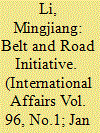

|
|
|
|
|
| Summary/Abstract |
The Belt and Road Initiative (BRI) has been regarded by international society as a major policy tool in China's geo-economic strategy. Under this policy platform, Beijing has pledged to invest billions of dollars in the infrastructure and industrial sectors across Eurasia and in the Indo-Pacific nations. It is widely believed that such huge amount of investment will inevitably generate significant geostrategic repercussions in these regions. In response to the BRI, the United States and other powers have come up with a ‘free and open Indo-Pacific’ strategy. This article attempts to address the following question: what impact is the BRI likely to have on the security ties between China and the other major players in the Indo-Pacific? The author finds that the BRI may significantly transform China's international security policy and the expansion of Beijing's security influence may further intensify the security competition between China and other major powers in the Indo-Pacific region. The article also proposes a new analytical angle for the study of geo-economics that unpacks the role of economic activities and processes in generating geopolitical intentions and catalysing geopolitical competition.
|
|
|
|
|
|
|
|
|
|
|
|
|
|
|
|
| 2 |
ID:
176243


|
|
|
|
|
| Summary/Abstract |
This article assesses how south-east Asian countries and the Association of Southeast Asian Nations (ASEAN) have responded to the ‘free and open Indo-Pacific’ (FOIP) strategies promoted by the United States and the other countries in the Quadrilateral Security Dialogue (the ‘Quad’: US, Japan, Australia and India). Their nuanced ripostes imply a persistent commitment to hedging and shifting limited alignments in the face of growing great rivalry and the lack of a clear FOIP vision among Quad members. In the face of external pressure to take sides, the ASEAN states are likely to keep hedging through working selectively with China and the United States. Given the United States' apparent preference to balance China and Trump's disregard for multilateralism, ASEAN's ability to maintain its centrality in the evolving regional architecture is in doubt—despite the Quad countries' (belated) accommodation of ASEAN in their FOIP strategies. However, the success of the US strategy depends on Washington's ability to build and sustain the requisite coalition to balance Beijing. ASEAN has undertaken efforts to enhance bilateral security collaboration with China and the United States respectively. In doing so, ASEAN is arguably seeking to informally redefine its centrality in an era of Great Power discord and its ramifications for multilateralism.
|
|
|
|
|
|
|
|
|
|
|
|
|
|
|
|
| 3 |
ID:
176246


|
|
|
|
|
| Summary/Abstract |
This article adopts a constructive approach to examining the problem of the Indo-Pacific construct. Through reflection on the east Asian experience, it proposes an analytical framework of developmental peace as a constellation of international practices, which means that the more economic development is prioritized by states in regional processes, the more likely it is that a sustainable peace will be achieved. States participating in regional integration comprise a community of practice. On the basis of a shared understanding that development is of overriding importance and underpins security and state legitimacy, the community takes economic development as the anchoring practice; this practice embodies and enacts constitutive rules and fundamental norms for a broader set of practices in regional processes, such as peaceful coexistence and non-interference. The more economic development is prioritized on domestic and regional agendas, the more likely it is that conflicts in the security realm will be relaxed or even resolved to protect security interests. The author draws some useful implications from the developmental peace in east Asia for the Indo-Pacific construct, among which the most important include building shared understandings on the prioritization of economic development, taking advantage of the Regional Comprehensive Economic Partnership (RCEP), Comprehensive and Progressive Agreement for Trans-Pacific Partnership (CPTPP) and the Asian Infrastructure Investment Bank, and using the code of conduct process as a vehicle and best practice to facilitate rule-making for the maritime order. Finally, the author briefly discusses the contributions of the study and limitations of the model.
|
|
|
|
|
|
|
|
|
|
|
|
|
|
|
|
| 4 |
ID:
176239
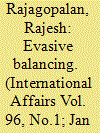

|
|
|
|
|
| Summary/Abstract |
India has adopted the Indo-Pacific concept with uncharacteristic speed. This article examines India's Indo-Pacific strategy, which evolved out of its earlier ‘Look East’ and ‘Act East’ policies but is much more focused on strategic concerns than on trade or connectivity. As such, the strategy is subset of its China policy, and includes contradictory elements of balancing China by building partnerships with the United States as well as with regional powers, while simultaneously pursuing a reassurance strategy to convince Beijing that India is not really balancing China. The combination of these contradictory elements is characterized as evasive balancing, which is a more useful concept than either pure balancing or hedging for understanding the policies of India and of many other countries in the region that are trying to manage China's rise. However, reassurance strategies rarely work and the combination of balancing and reassurance is even less likely to be viable.
|
|
|
|
|
|
|
|
|
|
|
|
|
|
|
|
| 5 |
ID:
176241


|
|
|
| 6 |
ID:
176242


|
|
|
|
|
| Summary/Abstract |
Indonesia has taken a leadership role within the Association of Southeast Asian Nations (ASEAN) in drafting a common outlook on the Indo-Pacific concept. The widening of Indonesia's geostrategic canvas from the Asia–Pacific to the Indo-Pacific is in line with President Joko Widodo's intent to make Indonesia a Global Maritime Fulcrum (GMF). In view of the rivalry between the US and China and the emergence of various Indo-Pacific initiatives from other countries, Indonesia believes that ASEAN must try to maintain its centrality. The draft of Indonesia's perspective for an ASEAN outlook on the Indo-Pacific: towards a peaceful, prosperous, and inclusive region was submitted for considerations by ASEAN, and after 18 months of intensive lobbying by Indonesia the concept was finally adopted at the ASEAN Summit in June 2019. The ASEAN outlook promotes the principles of openness, inclusiveness, transparency, respect for international law and ASEAN centrality in the Indo-Pacific region. It proposes a building-block approach, seeking commonalities between existing regional initiatives in which ASEAN-led mechanisms will act as a fulcrum for both norm-setting and concrete cooperation. Rather than creating a new regional architecture, the East Asia Summit (EAS) is proposed as the platform for advancing the Indo-Pacific discourse and cooperation. Indonesia's ASEAN outlook on the Indo-Pacific marks its renewed foreign policy activism as a middle power and underlines the continuing importance that Indonesia places on ASEAN as the cornerstone of its foreign policy, emphasising ASEAN's centrality as the primary vehicle for managing relations with the major powers in the Indo-Pacific region.
|
|
|
|
|
|
|
|
|
|
|
|
|
|
|
|
| 7 |
ID:
176244
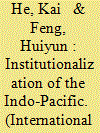

|
|
|
|
|
| Summary/Abstract |
Although the term ‘Indo-Pacific’ has become popular in the foreign policy discourse of some countries, we have yet to see any significant institution-building in the Indo-Pacific region. Borrowing insights from functional institutionalism and political leadership studies of international regimes, we introduce a ‘leadership–institution’ model to explore the problems and prospects of institutionalizing the Indo-Pacific. Through a comparative case study of the institutionalization of the Asia–Pacific vs the Indo-Pacific, we argue that two crucial factors contributed to the slow institutionalization of the Indo-Pacific as a regional system in world politics: the lack of ideational leadership from an epistemic community and the weak executive leadership from a powerful state. While ideational leaders can help states identify and expand common interests in cooperation, executive leadership will facilitate states to overcome operational obstacles in cooperation, such as the ‘collective action’ problem and the ‘relative gains’ concern. The future of institution-building in the Indo-Pacific will depend on whether and how these two leadership roles are played by scholars and states in the region. In the conclusion, we discuss the challenges of institutionalizing the Indo-Pacific and highlight China as a wild card in the future of Indo-Pacific regionalism.
|
|
|
|
|
|
|
|
|
|
|
|
|
|
|
|
| 8 |
ID:
176240
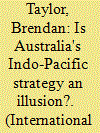

|
|
|
|
|
| Summary/Abstract |
Australia has been among the most prominent advocates of the increasingly popular Indo-Pacific concept. This article argues that Canberra's enthusiasm for the concept stems from its appeal to the two dominant traditions of Australian foreign policy—a ‘dependent ally’ tradition and a ‘middle power’ approach. While these two traditions are typically seen as being in tension, the Indo-Pacific concept provides a rare point of convergence between them. The article begins by outlining the appeal of the Indo-Pacific concept to each of these traditions. Using a case-study of recent Australian policy toward the South China Sea disputes, however, the article then demonstrates that Australia has in practice implemented its stated Indo-Pacific strategy far less consistently than its very vocal support would appear to suggest. This disjuncture is attributed to the growing influence of a third, generally understudied, ‘pragmatic’ Australian foreign policy tradition. Because Australia has been such a prominent champion of the Indo-Pacific concept, the article concludes that this divergence between the rhetoric and the reality of Australia's Indo-Pacific strategy threatens to have a negative impact on the concept's broader international appeal and sustainability, particularly among Australia's south-east Asian neighbours.
|
|
|
|
|
|
|
|
|
|
|
|
|
|
|
|
| 9 |
ID:
176238
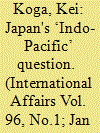

|
|
|
|
|
| Summary/Abstract |
Japan's primary objective of the ‘free and open Indo-Pacific’ (FOIP) strategy is to shape and consolidate regional order in the Indo-Pacific region based on the existing rules-based international order. The concept initially aimed to achieve two different objectives—shaping a regional order in the Indo-Pacific and ensuring the defence of Japan; however, Japan has gradually shifted its strategic focus onto the former, separating national defence from the FOIP concept, which reflects a change in the degree of its commitment to the two objectives. On the one hand, as its overall security strategy, Japan has determined to steadily enhance its national defence by increasing its own defence capabilities and strengthening the US–Japan alliance, while transforming its partnerships with like-minded states, such as Australia and India, into a diplomatic, and potentially military, alignment. This has been brought about by shifts in the regional balance of power, particularly the rise of China and the relative decline of the United States. On the other hand, as part of its FOIP strategy, Japan's attempts to build a new regional order in the Indo-Pacific region aim to defend the existing rules-based order established by the United States from challengers, particularly China. Yet, given the strategic uncertainty over Japan's international coalition-building efforts to create a new regional order, Japan has made its approach flexible; Tokyo is using its ambiguous FOIP concept to gauge other states' responses, understand their perspectives, and change its strategic emphases accordingly—so-called ‘tactical hedging’. Japan has pursued similar means to achieve the two key objectives. Nevertheless, the country's core interest, the defence of Japan, is more imperative than building a regional order in the Indo-Pacific region, and Japan faces different types of challenges in the future.
|
|
|
|
|
|
|
|
|
|
|
|
|
|
|
|
| 10 |
ID:
176237
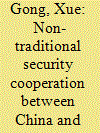

|
|
|
|
|
| Summary/Abstract |
The ‘free and open Indo-Pacific’ (FOIP) strategy, actively promoted by the United States with support from its allies and partners, is a significant geopolitical response to China's growing power and expanding influence in Asia and beyond. Beijing has adopted various new strategies to cope with the challenges related to FOIP. One of these strategies is to secure a robust relationship with south-east Asia in order to make these regional states either neutral to or less supportive of the Indo-Pacific vision. In addition to economic statecraft and soft power, Beijing believes that it can also tap into the domain of non-traditional security (NTS) to strengthen relations with this region to position itself better in the intensifying regional geopolitical competition. The article addresses the following question: what is the impact of China's NTS cooperation with south-east Asia on Beijing's geopolitical rivalry with other major powers in the Indo-Pacific region? The article argues that China's NTS cooperation with south-east Asian countries may help China maintain its geopolitical standing in the region, but it is unlikely to lead to any dramatic increase of China's strategic influence in the region. This essentially means that Beijing may be able to prevent ASEAN or most ASEAN member states from lending substantive and strong support to the Indo-Pacific construct, but it will not be able to stop ASEAN states from supporting some elements of the FOIP.
|
|
|
|
|
|
|
|
|
|
|
|
|
|
|
|
| 11 |
ID:
176236


|
|
|
|
|
| Summary/Abstract |
In response to the changing geopolitical landscape in Asia, both China and the United States attempt to alter the regional order in their own favour, both in the economic and security realms. This article shows how diverging views on future arrangements are leading to strategic shifts and increasing tension between these two Great Powers. As part of its quest for Great-Power status, China has been actively pushing its regional initiatives such as the Belt and Road Initiative (BRI) and the Asian Infrastructure Investment Bank (AIIB), as well as adopting assertive security policies towards its neighbours. In contrast, in order to counter China's growing influence America's regional strategy is undergoing a subtle shift from ‘rebalancing to Asia’ to focusing on the ‘Indo-Pacific’ region. However, amid an intensifying trade war and other challenges facing the region, China has chosen to moderate its proactive foreign policy-orientation in the past few years. In particular, China has made attempts to downplay its domestic rhetoric, rebuild strategic relationship with India and Japan, and to reassure ASEAN states in the South China Sea. In response to the Indo-Pacific strategy, it would be more effective for China to articulate a more inclusive regional vision and promote an institutional framework that also accommodates a US presence in the region.
|
|
|
|
|
|
|
|
|
|
|
|
|
|
|
|
| 12 |
ID:
176235
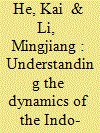

|
|
|
|
|
| Summary/Abstract |
As a geographical concept, ‘Indo-Pacific’ has existed for decades. As a political and strategic concept, it has since 2010 gradually become established in the foreign policy lexicon of some countries, especially Australia, India, Japan and the United States. However, China seems to be reluctant to identify itself as part of the Indo-Pacific; Chinese leaders believe that the US-led Indo-Pacific strategy aims to contain China's rise. While the battle between the two geographical concepts ‘Indo-Pacific’ and ‘Asia–Pacific’ may be fairly easily settled in the future, US–China strategic competition has just begun. Will the Indo-Pacific become a battlefield for US–China rivalry? How will China cope with the US ‘free and open Indo-Pacific’ (FOIP) strategy? How will other regional actors respond to the US–China strategic competition in the Indo-Pacific? What are the strategic implications of the ‘Indo-Pacific’ concept for regional order transformation? How will the Indo-Pacific be institutionalized, economically, politically and strategically? This article introduces the January 2020 special issue of International Affairs, which aims to address those questions, using both country-specific and regional perspectives. Seven articles focus on the policy responses of major players (Australia, China, India, Indonesia, Japan and ASEAN) to the US FOIP strategy and related US–China rivalry in the region. A further three articles examine the profound implications of Indo-Pacific dynamics for regional institution-building and for geopolitical and geo-economic architecture.
|
|
|
|
|
|
|
|
|
|
|
|
|
|
|
|
| 13 |
ID:
176247
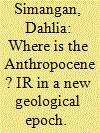

|
|
|
|
|
| Summary/Abstract |
Several disciplines outside the natural sciences, including International Relations (IR), have engaged with the Anthropocene discourse in order to theorize their relevance and translate their practical value in this new phase of the Earth's history. Some IR scholars have called for a post-humanist IR, planet politics, a cosmopolitan view, and ecological security, among other approaches, to recalibrate the theoretical foundations of the discipline, making it more attuned to the realities of the Anthropocene. Existing discussions, however, tend to universalize human experience and gravitate towards western ontologies and epistemologies of living in the Anthropocene. Within this burgeoning scholarship, how is the IR discipline engaging with the Anthropocene discourse? Although the Anthropocene has become a new theoretical landscape for the conceptual broadening of conventional IR subjects, this review reveals the need for sustained discussion that highlights the differentiated human experiences in the Anthropocene. The existing IR publications on the Anthropocene locates the non-spatial narratives of vulnerability and historical injustice, the non-modernist understanding of nature, the agency of the vulnerable, and the amplification of security issues in the Anthropocene. It is in amplifying these narratives that the IR discipline can broaden and diversify the discourse on the Anthropocene and, therefore, affirm its relevance in this new geological age.
|
|
|
|
|
|
|
|
|
|
|
|
|
|
|
|
|
|
|
|
|